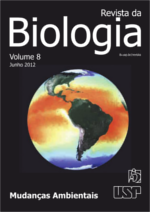Distribuição de Rhinella granulosa: integrando envelopes bioclimáticos e respostas ecofisiológicas
DOI:
https://doi.org/10.7594/revbio.08.07Palavras-chave:
Tolerância termal, gradiente de temperatura, BIOCLIM, modelagem de distribuição de espéciesResumo
Neste trabalho utilizamos as abordagens correlativa e mecanística de modelagem para construir modelos de distribuição potencial atual de Rhinella granulosa. Os modelos correlativos gerados por várias variáveis climáticas (BIOCLIM1) foi o mais conservativo, um segundo com temperatura apenas (BIOCLIM2) apresentou manchas descontínuas e o mecanístico indicou habitats termais mais adequados numa extensa área contínua. O BIOCLIM1 apresentou maior acurácia na predição da distribuição do que o BIOCLIM2. O BIOCLIM1 também apresentou melhor desempenho, seguido pelo BIOCLIM2 e pelo modelo mecanístico. A diferença nas áreas de distribuição potencial entre os modelos provavelmente se deva ao uso de diferentes variáveis preditoras e podem ser reflexo de uma limitação de interações bióticas interespecíficas. Por ser ectotérmica, esta espécie nos permite avaliar melhor a influência da temperatura, através de dados ambientais e de tolerância termal da espécie, sobre sua área de distribuição potencial, bem como avaliar o desempenho dessas abordagens na elaboração de modelos de distribuição potencial de espécies e fazer inferências acerca de cenários futuros de aumento na temperatura.Downloads
Downloads
Publicado
2018-04-23
Edição
Seção
Artigo
Licença
Salientamos que nossa revista não detém copyright, estes são exclusivos do autor do texto. Pretendemos com isso não criar entraves ao acesso do material publicado e atingir com mais intensidade nosso objetivo de divulgação da ciência.
Como Citar
Cassemiro, F. A. S., Gouveia, S. F., & Diniz-Filho, J. A. F. (2018). Distribuição de Rhinella granulosa: integrando envelopes bioclimáticos e respostas ecofisiológicas. Revista Da Biologia, 8(1), 38-44. https://doi.org/10.7594/revbio.08.07








 revistadabiologia@ib.usp.br
revistadabiologia@ib.usp.br 2008 - 2024 Revista da Biologia
2008 - 2024 Revista da Biologia